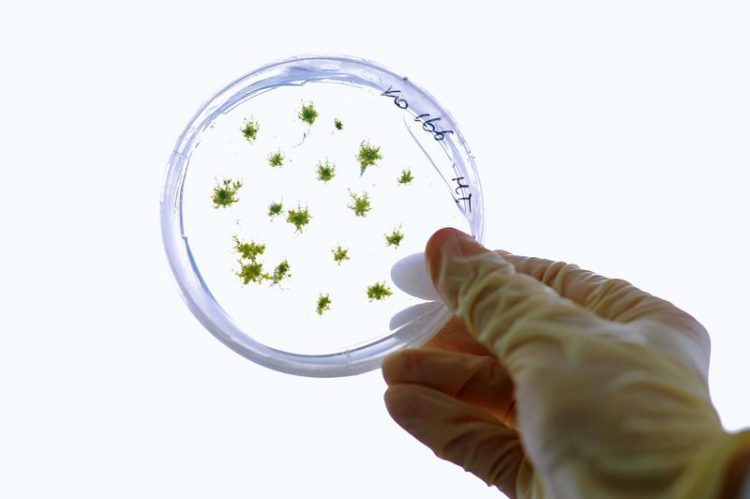How to get rid of proteins

Physcomitrella patens moss plants in a petri dish. Photo: Sigrid Gombert, Freiburg
All life forms depend on proteins which are encoded by genes. Whereas the regulation of protein amounts and activities is analysed in many laboratories, the signals that lead to a regulated degradation of specific proteins are far less well understood.
A German team led by the Freiburg-based biologist Professor Ralf Reski has discovered substrates and interaction partners of the so-called N-end rule pathway of protein degradation in the moss Physcomitrella patens. The study is published in the journal “Molecular and Cellular Proteomics”.
From previous research it was evident that an enzyme called ATE flags proteins with the amino acid arginine and that these arginylated proteins are subsequently degraded by the proteasome. “In humans, mice and flies ATE function is essential. Without it, embryos die”, Reski says.
His team had previously discovered that the moss Physcomitrella patens is more robust, as loss of ATE function affects development and energy storage but does not result in moss plants dying. Although the N-end rule pathway of protein degradation was discovered in 1986, it was unclear which proteins are flagged by ATE in plants.
For their current study the team from the Plant Biotechnology department of the University of Freiburg co-operated with Professor Andreas Schlosser and his group from the Rudolf Virchow Center for Experimental Biomedicine of the University of Würzburg.
Together, they developed novel methods in immuno-precipitation and mass spectrometry of arginylated proteins and found five needles in the haystack: After analysing about thirty thousand protein spectra the scientists identified four specific proteins that are flagged by ATE and a small heat shock protein that may act as a molecular chaperone to support ATE function. “Our results provide mechanistic insights into the targeted protein degradation in plants”, Reski says. “They may also help to increase the production of human proteins in moss.” Recently, the first moss-made human protein received the approval of the German regulatory authority BfArM for clinical trials.
The biologists from Freiburg are specialists in moss research and have helped to develop Physcomitrella as a model organism for biology and biotechnology at a world-wide scale. Research was supported by the German Research Foundation DFG, the Freiburg Cluster of Excellence BIOSS Centre for Biological Signalling Studies and the Freiburg Institute for Advanced Studies FRIAS of the University of Freiburg.
Ralf Reski heads the Chair of Plant Biotechnology at the University of Freiburg. The biologist is a member of BIOSS and was Senior Fellow at FRIAS and at USIAS, the University of Strasbourg Institute for Advanced Study, France.
Original Publication:
Sebastian N.W. Hoernstein, Stefanie J. Mueller, Kathrin Fiedler, Marc Schuelke, Jens T. Vanselow, Christian Schüssele, Daniel Lang, Roland Nitschke, Gabor L. Igloi, Andreas Schlosser, Ralf Reski (2016): Identification of targets and interaction partners of arginyl-tRNA protein transferase in the moss Physcomitrella patens. Molecular and Cellular Proteomics, DOI: 10.1074/mcp.M115.057190.
Contact:
Professor Dr. Ralf Reski
Chair Plant Biotechnology
Faculty of Biology
University of Freiburg
Germany
Phone: +49 761 203 6968
E-Mail: pbt@biologie.uni-freiburg.de
Media Contact
All latest news from the category: Life Sciences and Chemistry
Articles and reports from the Life Sciences and chemistry area deal with applied and basic research into modern biology, chemistry and human medicine.
Valuable information can be found on a range of life sciences fields including bacteriology, biochemistry, bionics, bioinformatics, biophysics, biotechnology, genetics, geobotany, human biology, marine biology, microbiology, molecular biology, cellular biology, zoology, bioinorganic chemistry, microchemistry and environmental chemistry.
Newest articles

Superradiant atoms could push the boundaries of how precisely time can be measured
Superradiant atoms can help us measure time more precisely than ever. In a new study, researchers from the University of Copenhagen present a new method for measuring the time interval,…

Ion thermoelectric conversion devices for near room temperature
The electrode sheet of the thermoelectric device consists of ionic hydrogel, which is sandwiched between the electrodes to form, and the Prussian blue on the electrode undergoes a redox reaction…

Zap Energy achieves 37-million-degree temperatures in a compact device
New publication reports record electron temperatures for a small-scale, sheared-flow-stabilized Z-pinch fusion device. In the nine decades since humans first produced fusion reactions, only a few fusion technologies have demonstrated…





















